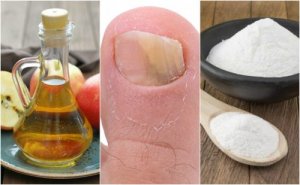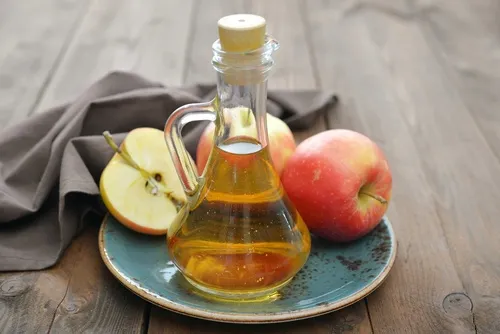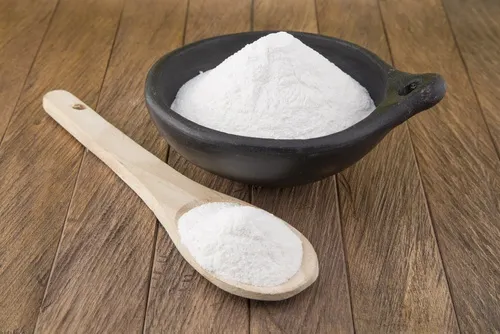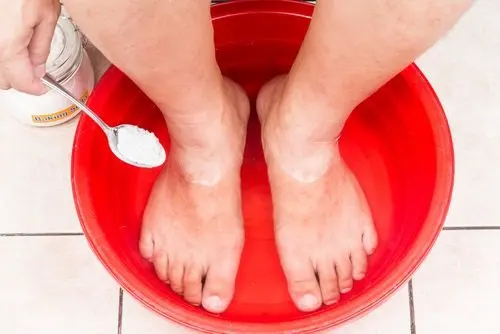Control Nail Fungus with Apple Cider Vinegar and Baking Soda


Reviewed and approved by the doctor Maricela Jiménez López
Nail fungus is a common though uncomfortable problem but you can control it. The main cause is the growth of dermatophytes or yeasts, which develop in humid or contaminated environments.
It isn’t a serious condition but alters the color, shape and texture of the nails and makes them brittle. Treatment includes the use of antifungals, some of which are natural.
For example, you can control nail fungus with apple cider vinegar and baking soda. Two antifungals that don’t cause unwanted side effects. In the following space we’ll tell you about their health benefits and how to make them at home. It’s quite simple really.
Nail fungus: causes and symptoms
Also known as onychomycosis, this fungus is a common infection caused by the overgrowth of dermatophytes or yeasts, as stated in this study conducted by the University of the Republic in Uruguay.
Its main cause is contact with contaminated environments, such as floors or footwear. However, it can also be due to a weakened immune system and excessive sweating.
It goes unnoticed at first but the nails eventually become yellowish. This is almost always followed by weakening that affects their structure and makes them brittle.
Check out A Natural Alcohol Based Remedy Against Nail Fungus
Apple cider vinegar and baking soda: a natural treatment to fight nail fungus
This apple cider vinegar and baking soda treatment is a natural choice to get rid fungal infections that can affect the structure of the nails. It stops the growth of microorganisms, preventing weakening, and yellow or dark discoloration.
You cannot cure a fungal infection overnight but the regular application of this treatment will keep the infection from spreading and contaminating others. We would also recommend consulting a podiatrist who can recommend the best treatment.
Furthermore, it’s also important to maintain good hygiene habits. A good body cleansing routine is crucial for disrupting the environment that the fungus requires to grow.
The health properties of apple cider vinegar

Apple cider vinegar is obtained by the process of fermentation. This process releases healthy bacteria and yeasts.
According to this study by the Postgraduate Program in Dentistry in Sao Paulo, Brazil, this is also responsible for the powerful antifungal, antibacterial properties, and characteristic acidity of apple cider vinegar.
- This substance contains malic and acetic acid, two alkaline substances that help stop yeast infections
- Its regular application disturbs the environment that fungus needs to reproduce
- It also contains an interesting amount of bioflavonoids, vitamins, minerals and fibers which, among other things, are great for the skin
The health properties of baking soda

Baking soda is a natural product used for cooking, home cleaning, and medicinal purposes.
- As shown in this study by the University of Sao Paulo, Brazil, it has antiseptic, alkaline and antimycotic properties, which can facilitate the control of various types of internal and external infections.
- Topical use removes dead cells that accumulate on the surface of the skin.
- It’s ideal for regulating the pH level of your skin. It also decreases sweating (as stated in this investigation by the New York University) and other conditions that facilitate the development of fungi and bacteria.
You may also like Natural Remedies with Baking Soda
Making an apple cider vinegar and baking soda treatment to control nail fungus

This apple cider vinegar and baking soda treatment requires two simple steps:
- First, apply the apple cider vinegar directly onto the nails, either by soaking your feet in the vinegar, or applying it with cotton wool
- Then after several minutes, use baking soda to enhance the anti-fungal properties
Ingredients
- 6 c. of water (1.5 liters)
- ½ c. of apple cider vinegar (125 ml)
- 7 ½ tbsp. of baking soda (75 g)
Preparation
- Heat up some water until it reaches a tolerable temperature for your skin. Then add the apple cider vinegar.
- Dip your feet into the liquid and let them soak for 15 minutes.
- Then, dry your feet and apply the baking soda with gentle exfoliating massages.
- Rub this substance directly on your nails and let it do its thing for 15 more minutes.
- Rinse your feet with warm water and dry them again.
- Repeat the treatment every night to improve the appearance of affected nails.
Other remedies for nail fungus
There are several natural remedies you can use in addition to apple cider vinegar and baking soda for nail fungus control. Here are some of them:
- Tea tree oil
- Oregano
- Olive leaf extract
- Garlic
- Propolis
Consistency in nail fungus control
You must be constant with the treatment for onychomycosis, both in hands and feet, to subject the dermatophytes to an acidic environment that facilitates their total elimination.
Keep in mind that a mixture of apple cider vinegar and baking soda can eliminate nail fungus. However, it requires a lot more than a single application.
All cited sources were thoroughly reviewed by our team to ensure their quality, reliability, currency, and validity. The bibliography of this article was considered reliable and of academic or scientific accuracy.
- Piraccini BM, Alessandrini A. Onychomycosis: A Review. J Fungi (Basel). 2015;1(1):30–43. Published 2015 Mar 27. doi:10.3390/jof1010030
- Elewski BE. Onychomycosis: pathogenesis, diagnosis, and management. Clin Microbiol Rev. 1998;11(3):415–429.
- Mas, A., Troncoso, A. M., García-Parrilla, M. C., & Torija, M. J. (2015). Vinegar. In Encyclopedia of Food and Health. https://doi.org/10.1016/B978-0-12-384947-2.00726-1
- Lookabill, S. K., Dulaney, A. R., Shepherd, G., & Kerns, W. P. (2017). Sodium bicarbonate. In Critical Care Toxicology: Diagnosis and Management of the Critically Poisoned Patient. https://doi.org/10.1007/978-3-319-17900-1_169
- Halteh P, Scher RK, Lipner SR. Over-the-counter and natural remedies for onychomycosis: do they really work? Cutis. 2016;98(5);E16-E25.
- Bodman MA, Krishnamurthy K. Onychomycosis. [Actualizado 2019 8 de junio]. En: StatPearls [Internet]. Treasure Island (FL): StatPearls Publishing; 2019 ene-. Disponible en: https://www.ncbi.nlm.nih.gov/books/NBK441853/
- Woods-Panzaru S, Nelson D, McCollum G, Ballard LM, Millar BC, Maeda Y, Goldsmith CE, Rooney PJ, Loughrey A, Rao JR, Moore JE. An examination of antibacterial and antifungal properties of constituents described in traditional Ulster cures and remedies. Ulster Med J. 2009; 78(1): 13-15.
This text is provided for informational purposes only and does not replace consultation with a professional. If in doubt, consult your specialist.








